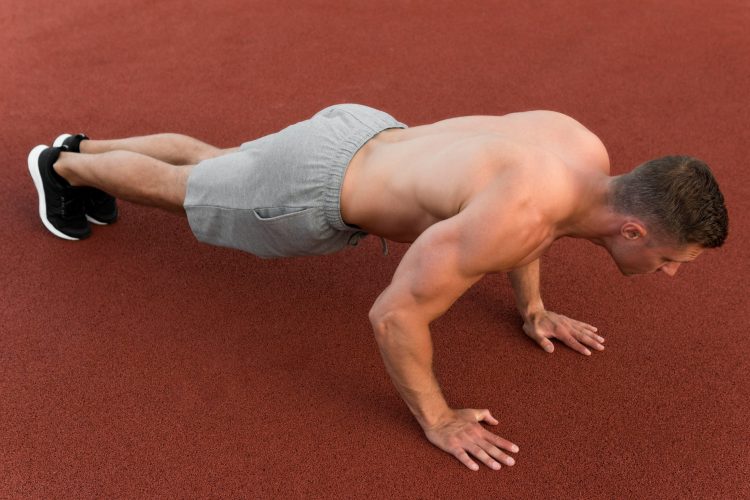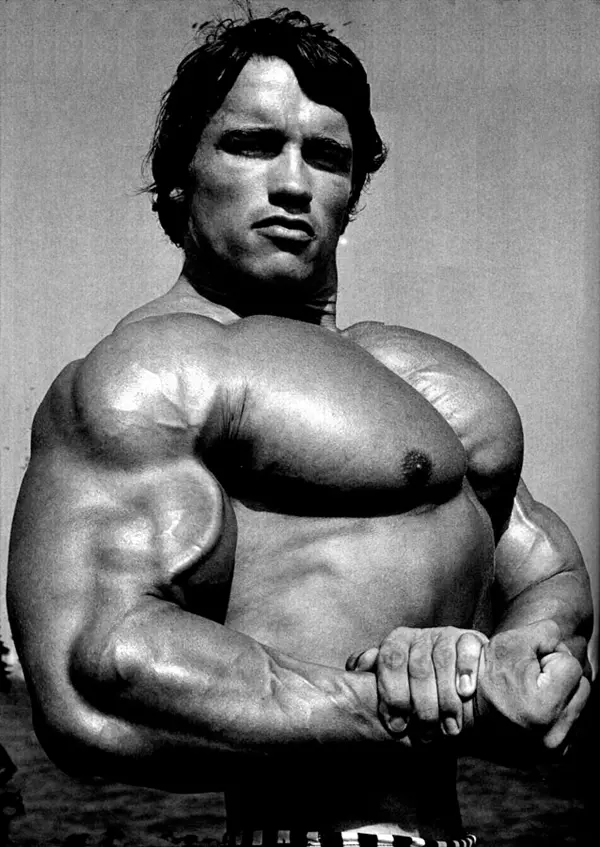I am always looking for new ways to challenge myself and my clients, so I recently took on a mini fitness challenge: 50 Russian push-ups every day for one week.
Of course, my goal wasn’t to transform my physique in seven days — that’s impossible. I simply wanted to see if there’s room for Russian push-ups in my calisthenics routine and whether I should start incorporating this push-up alternative in my clients’ programs.
So, here’s what happened after a week of Russian push-ups.
50 Russian Push-Ups For A Week — Key Takeaways
I noticed several things right away, but after a week of daily Russian push-ups, the following stood out to me the most:
They Are Harder Than I Expected
Going into this challenge, I knew that Russian push-ups would be more demanding than regular ones. However, I was still taken aback by how difficult they were. I can’t imagine anyone progressing to them without being able to knock out 15–20 conventional push-ups.
They are extremely taxing on your triceps, delts, and forearms. Dropping to a forearm plank requires a ton of stability and forearm strength, and returning to a bottom push-up position takes a toll on your delts and triceps. The entire motion requires a high degree of coordination, strength, and stability to execute correctly, even if you’re a well-trained individual.
Level Up Your Fitness: Join our 💪 strong community in Fitness Volt Newsletter. Get daily inspiration, expert-backed workouts, nutrition tips, the latest in strength sports, and the support you need to reach your goals. Subscribe for free!
My front delts and triceps were on fire after the third 10-rep set on the first day, and I was genuinely wondering if I could do this for a whole week.
Mastering the Technique Takes Time
Mastering the Russian push-up technique isn’t easy. In fact, unless you’re an intermediate lifter with several years of training experience, a week won’t cut it. With so many moving parts, it is quite easy to lose focus and end up with an arched back or sagging hips.
To prevent bad form, I recorded myself doing this exercise. I noticed that my back wasn’t as straight as it needed to be after six or seven reps, so I needed to work on that. I also wanted to make the movement more fluid and prevent dropping to my elbows, but that one was too hard for me at this point, so don’t stress if you don’t do it perfectly right away.
You Probably Shouldn’t Do Them Every Day
While bodyweight exercises are generally easy to recover from and can probably be done five to six times per week, I wouldn’t recommend doing Russian push-ups that often. This exercise is exceptionally strenuous. I felt quite beat up by day six even though I wasn’t sore, and that was a clear sign I overdid it.
So, if your goal is to become stronger or gain lean muscle, I’d say take a one-day break between your sessions. If you do them every day, you won’t recover fully, which means you won’t be able to execute the push-ups with proper form, leaving gains on the table and increasing your chance of injury. (1)
How To Perform Russian Push-ups With Good Form
As I said, mastering the Russian push-up is hard, so paying attention to every minute detail as you go through the motions is critical. To help you out with that, here’s a detailed step-by-step guide on how to perform a clean Russian push-up:
Step One — Assume the Starting Position
Start in a standard push-up position with your hands placed slightly wider than your shoulders. Your body should form a straight line from your shoulders to your heels.
Pro Tip: Brace your core and glutes to keep your body straight and prevent your chest and hips from sagging.
Step Two — Lower Into the Push-Up
Slowly lower your body until your chest is a few inches above ground. At the bottom, your shoulder should be ahead of your palms. Keep your elbows close to your body to engage your triceps and protect your shoulder and elbow joints.
Pro Tip: Stay in control during the entire movement.
Step Three — Transition to Forearm Plank
From the bottom push-up position, shift your weight back and lower your elbows and forearms to the ground. Your front delts, triceps, forearms, and core should be fully engaged.
Pro Tip: Push back with your arms, and don’t use your feet to drag yourself back.
Step Four — Return to the Bottom Push-Up Position
Press your hands into the ground, lift your elbows, and move your weight forward to return to the bottom push-up position. Make sure your body remains straight, and avoid sagging your hips.
Pro Tip: Push forward as if trying to rock your body forward. Also, don’t use your legs.
Step Five — Complete the Push-Up
Fully extend your elbows to return to the starting position. When at the top, protract your scapulas to get a better stretch.
Pro Tip: Use an explosive motion on the ascent.
Benefits of Russian Push-Ups
Aside from being fun and challenging, after a week of doing Russian push-ups, I realized they can be incredibly beneficial in the following ways:
Level Up Your Fitness: Join our 💪 strong community in Fitness Volt Newsletter. Get daily inspiration, expert-backed workouts, nutrition tips, the latest in strength sports, and the support you need to reach your goals. Subscribe for free!
Adds Variety Into Your Routine
Sticking to the same workout routine for an extended period can become monotonous, which could make you want to skip your training sessions. However, by incorporating multi-movement exercises like Russian push-ups into your routine, you can find a new and exciting way to challenge your body.
Another thing to keep in mind is that you will eventually adapt to certain movements, even if you keep challenging yourself by adding reps or increasing weight. Russian push-ups help with that. I’ve noticed that even though I frequently do push-ups and planks, the transition between the two makes it challenging to excel at either, making training more fun.
Builds Upper Body Strength
This is hands-down one of the best strength-building bodyweight exercises I’ve tried in a while. It trains your chest, shoulders, triceps, upper back, forearms, and core.
Also, due to the somewhat complex movement involved (the transition between a push-up and a plank), the Russian push-up helps train your upper-body muscles in a way you haven’t trained them before.
Improves Core Strength and Stability
Russian push-ups require a ton of core strength and stability. As you go through the motions, your core muscles must work continuously to keep your pelvis up and your back straight. This constant engagement can boost abdominal wall strength and stability. Also, your lower back will become stronger too.
A stronger core (and lower back) can help eliminate lower back pain, boost athletic performance, and improve overall stability and posture.
Bulletproofs Your Joints
When performed with proper form, Russian push-ups can improve joint health. Since you’re only using your body weight, you do not place a massive strain on your joints, making it easier for them to adapt and grow stronger.
Also, the movements you perform help build tendon and ligament strength in your shoulders, elbows, and wrists in positions you’re not normally in. So, by performing Russian push-ups regularly, you can make your joints less susceptible to injury in semi-awkward positions, helping you in everyday life and sports.
Requires No Equipment
Push-ups are easy to overload, but in most cases, you need equipment. If you want to increase the ROM, you’ll need push-up handles or chairs; if you want to increase the load, you’ll probably have to get a weighted vest. With Russian push-ups, you don’t need any of that.
The transition between the push-up and plank positions makes the exercise substantially harder on your shoulders and triceps. They help you overcome a plateau and progress without any equipment.
It Can Be Scaled
While I did say this exercise is quite complex and not suitable for beginners, that doesn’t mean it can’t be scaled to suit almost everyone’s fitness levels.
If you’re a beginner, you can start by performing Russian push-ups on your knees. This will reduce the weight you have to move, making it much less taxing on the arms. Conversely, advanced lifters can use weighted vests.
Drawbacks of Russian Push-Ups
While I was more than impressed with Russian push-ups during my week-long challenge, there are a few drawbacks we must discuss.
Limited Chest Activation
If you want to make push-ups more challenging and train your chest more effectively, Russian push-ups aren’t the best option. Due to their complex movement, the variation biases the triceps and shoulders.
Of course, this doesn’t mean it won’t train your chest. However, your triceps and shoulder will tire much faster than your chest, meaning you won’t be able to push long and hard enough for your chest to receive enough growth-promoting stimulus.
Weighted or deficit push-ups are a much better option to promote hypertrophy. (2)
Not Ideal For Hypertrophy
Speaking of hypertrophy, Russian push-ups shouldn’t be your go-to option if you’re training for hypertrophy. Even though they are more challenging than regular push-ups, the workload is spread across multiple muscle groups. This will lead to a lower stimulus to any one area or muscle group, effectively hindering muscle growth.
Jeff Nippard, a professional natural bodybuilder and a science-based content creator, discussed the pros and cons of push-ups:
“Once you get decently strong, you’ll need to do at least 30-plus reps to get close enough to failure to maximize muscle growth — which isn’t ideal. I do think that’s fine if you’re doing them as an end-of-workout finisher, but otherwise, doing all those reps can be exhausting for no added benefit.
You also come up solid against the floor before your pecs are fully stretched, and they’re not that easy to overload. While you can have a partner add some weight to your back, the weight always feels a bit unstable.”
Can Cause Injury
While I previously said they will do wonders for your joints, that’s only true if you perform them with perfect form. That said, you might injure yourself if you perform Russian push-ups with suboptimal technique (especially once the fatigue kicks in).
The most common injuries are elbow and shoulder joint strains and scapular injuries, but you could also injure your back muscles if you start compensating for the lack of strength in your arms. So, if you can’t do it with proper form, don’t do it at all.
FAQ’s
What are the primary muscles worked by Russian push-ups?
The primary muscles worked are the triceps, shoulders, chest, and core. The lower back is also engaged during the planking portion of the push-up.
Can Russian push-ups help improve my overall fitness?
Russian push-ups can definitely improve overall fitness. They improve muscle strength, endurance, coordination, and stability.
How many Russian push-ups should I do in a set?
Start with a manageable number, between five and 15 push-ups per set, and gradually increase as your strength and technique improve.
What common mistakes should I avoid when doing Russian push-ups?
Common mistakes you should avoid include sagging the hips, flaring the elbows, rushing through the movement, and crashing your elbows into the floor on the lowering phase.
Wrapping Up
All in all, I had a very pleasant experience doing Russian push-ups every day for a week. It was interesting and challenging and made me realize that there are always areas of your body you haven’t paid as much attention to as you should have.
I will definitely keep doing Russian push-ups as a part of my calisthenics routine, and I suggest you do the same if regular push-ups have become too easy. Just be mindful of the technique, and you’ll reap the benefits.
Read also: How Mike Tyson Push-Ups Transformed My Upper Body Strength in Just 30 Days
References:
- Judge LW, Burke JR. The effect of recovery time on strength performance following a high-intensity bench press workout in males and females. Int J Sports Physiol Perform. 2010 Jun;5(2):184-96. doi: 10.1123/ijspp.5.2.184. PMID: 20625191.
- Pedrosa GF, Lima FV, Schoenfeld BJ, Lacerda LT, Simões MG, Pereira MR, Diniz RCR, Chagas MH. Partial range of motion training elicits favorable improvements in muscular adaptations when carried out at long muscle lengths. Eur J Sport Sci. 2022 Aug;22(8):1250-1260. doi: 10.1080/17461391.2021.1927199. Epub 2021 May 23. PMID: 33977835.










